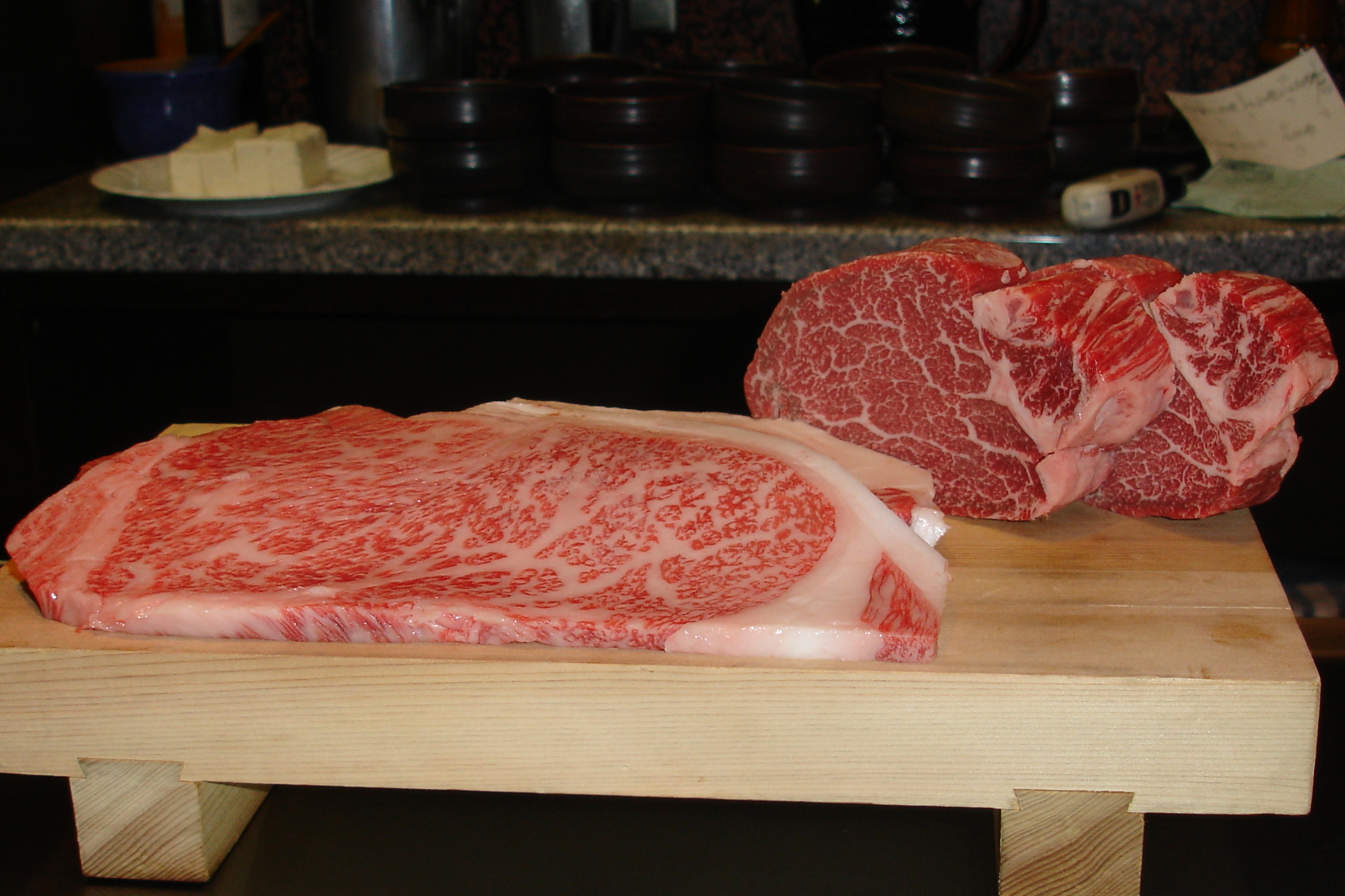Marbled Meat on:
[Wikipedia]
[Google]
[Amazon]
 Marbled meat is meat, especially
Marbled meat is meat, especially 
 Marbled meat is meat, especially
Marbled meat is meat, especially red meat
In gastronomy, red meat is commonly red when raw and a dark color after it is cooked, in contrast to white meat, which is pale in color before and after cooking. In culinary terms, only flesh from mammals or fowl (not fish) is classified a ...
, that contains various amounts of intramuscular fat, giving it an appearance similar to marble
Marble is a metamorphic rock composed of recrystallized carbonate minerals, most commonly calcite or dolomite. Marble is typically not foliated (layered), although there are exceptions. In geology, the term ''marble'' refers to metamorphose ...
.

Important terms defined
''Beef quality grades'' - A quality grade is a composite evaluation of factors that affect palatability of meat ( tenderness, juiciness, and flavor). These factors include carcass maturity, firmness, texture, and color of lean, and the amount and distribution of marbling within the lean. Beef carcass quality grading is based on (1) degree of marbling and (2) degree of maturity. ''Marbling'' - (intramuscular fat) is the intermingling or dispersion of fat within the lean. Graders evaluate the amount and distribution of marbling in the ribeye muscle at the cut surface after the carcass has been ribbed between the 12th and 13th ribs. Degree of marbling is the primary determination of quality grade. ''Maturity'' refers to the physiological age of the animal rather than the chronological age. Because the chronological age is virtually never known, physiological maturity is used; the indicators are bone characteristics,ossification
Ossification (also called osteogenesis or bone mineralization) in bone remodeling is the process of laying down new bone material by cells named osteoblasts. It is synonymous with bone tissue formation. There are two processes resulting in ...
of cartilage
Cartilage is a resilient and smooth type of connective tissue. In tetrapods, it covers and protects the ends of long bones at the joints as articular cartilage, and is a structural component of many body parts including the rib cage, the neck ...
, and the color and texture of ribeye muscle. Cartilage becomes bone, lean color darkens and texture becomes coarser with increasing age. Cartilage and bone maturity receives more emphasis because lean color and texture can be affected by other postmortem factors.
''Beef yield grades'' - In beef, yield grades estimate the amount of boneless, closely trimmed retail cuts from the high-value parts of the carcass–the round, loin, rib, and chuck. However, they also show differences in the total yield of retail cuts. We expect a YG 1 carcass to have the highest percentage of boneless, closely trimmed retail cuts, or higher cutability, while a YG 5 carcass would have the lowest percentage of boneless, closely trimmed retail cuts, or the lowest cutability. The USDA Yield Grades are rated numerically and are 1, 2, 3, 4, and 5. Yield Grade 1 denotes the highest yielding carcass and Yield Grade 5, the lowest.
United States grading system
The USDA's grading system, which has been designed to reward marbling, has eight different grades; Prime, Choice, Select, Standard, Commercial, Utility, Cutter and Canner. Prime has the highest marbling content when compared to other grades, and is capable of fetching a premium atrestaurant
A restaurant is a business that prepares and serves food and drinks to customers. Meals are generally served and eaten on the premises, but many restaurants also offer take-out and food delivery services. Restaurants vary greatly in appearan ...
s and supermarket
A supermarket is a self-service shop offering a wide variety of food, beverages and household products, organized into sections. This kind of store is larger and has a wider selection than earlier grocery stores, but is smaller and more limit ...
s. Choice is the grade most commonly sold in retail outlets, and Select is sold as a cheaper option in many stores. Prime, Choice, Select and Standard are commonly used in the younger cattle (under 42 months of age), and Commercial, Utility, Canner and Cutter are used in older cattle carcasses which are not marketed as wholesale beef "block" meat, but as material used in ground products and cheaper steak
A steak is a thick cut of meat generally sliced across the muscle fibers, sometimes including a bone. It is normally grilled or fried. Steak can be diced, cooked in sauce, such as in steak and kidney pie, or minced and formed into patti ...
s for family restaurant
Restaurants fall into several industry classifications, based upon menu style, preparation methods and pricing, as well as the means by which the food is served to the customer. This article mainly describes the situation in the USA, while catego ...
s.
See also
*Artificial marbling
Artificial marbling is the injection of animal fat and/or vegetable oil into lean meat in order to simulate the appearance of marbling and attempt to improve the palatability of inexpensive cuts by preventing them from drying out or losing flavo ...
* Boston butt
A Boston butt is the slightly wedged shaped portion of the pork shoulder above the standard picnic cut which includes the blade bone and the "lean butt" (which is boneless), both extensions of the tenderloin cut and can be used in place of the te ...
* Entrecôte
* List of steak dishes
This is a list of steak dishes. Steak is generally a cut of beef sliced perpendicular to the muscle fibers, or of fish cut perpendicular to the spine. Meat steaks are usually grilled, pan-fried, or broiled, while fish steaks may also be bake ...
* Piedmontese beef
* Rib eye steak
The rib eye or ribeye (known as Scotch fillet in Australia and New Zealand) is a boneless rib steak from the rib section.
Description
Ribeye steaks are mostly composed of the longissimus dorsi muscle but also contain the complexus and spina ...
References